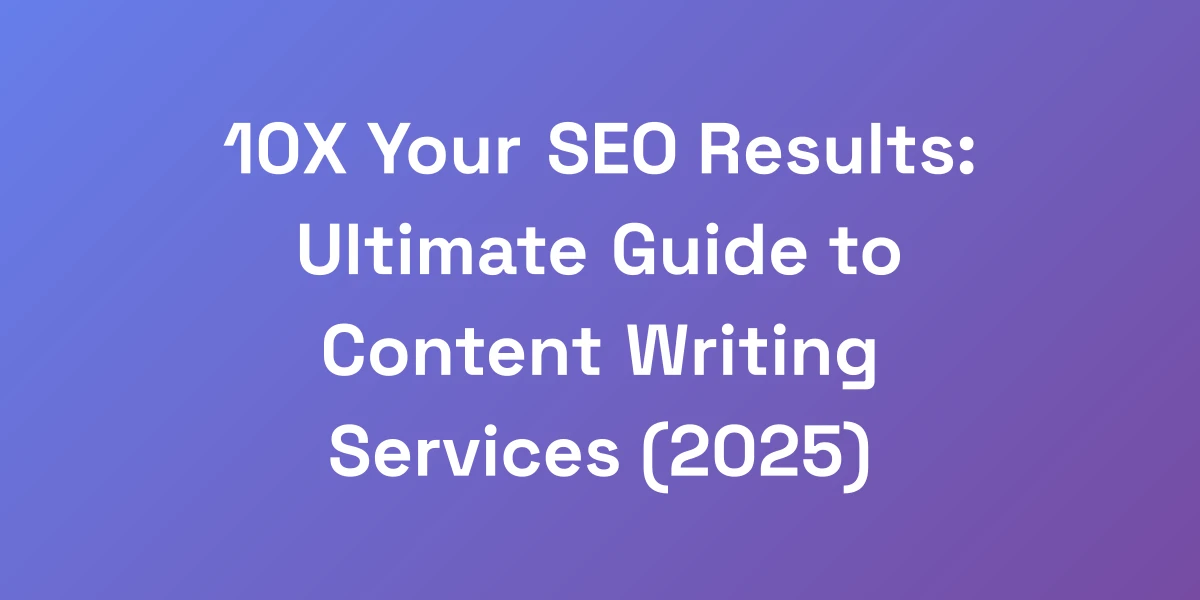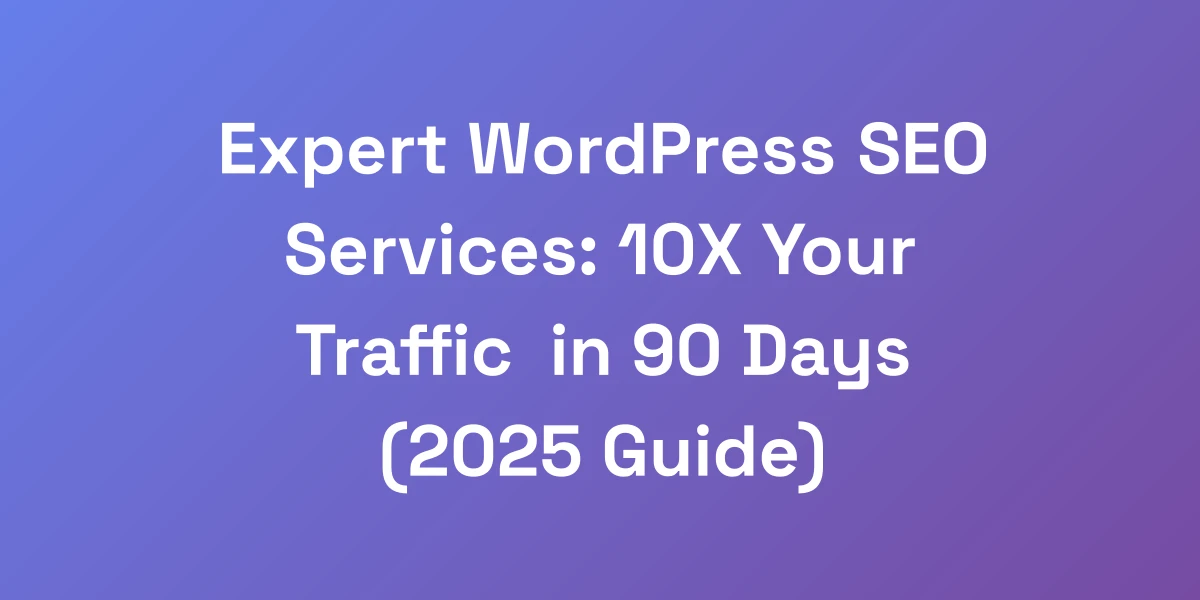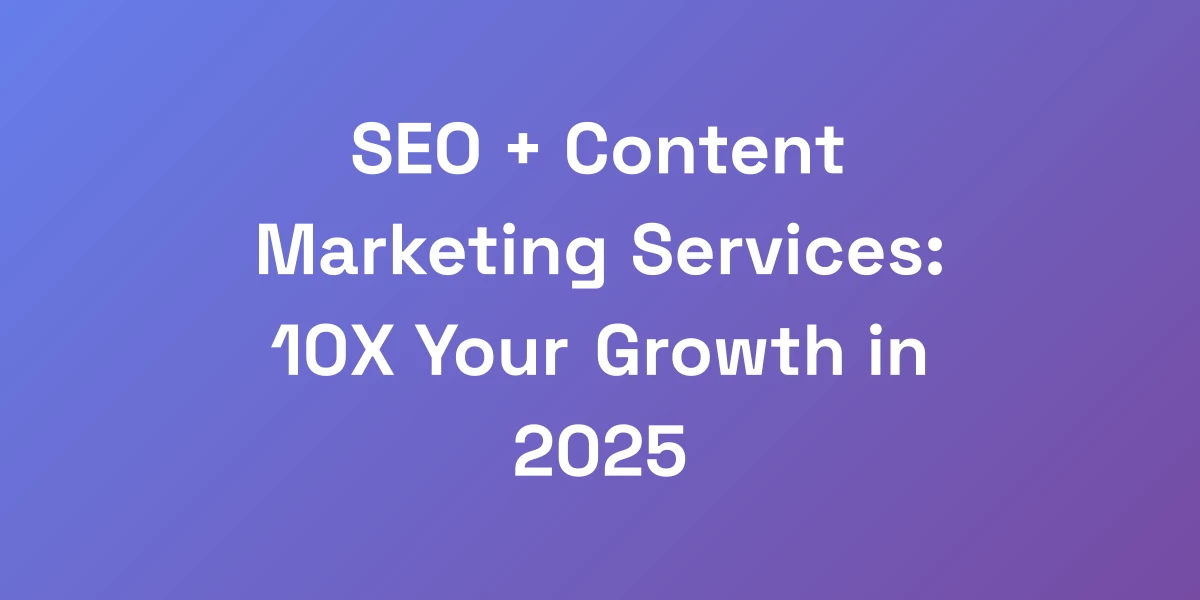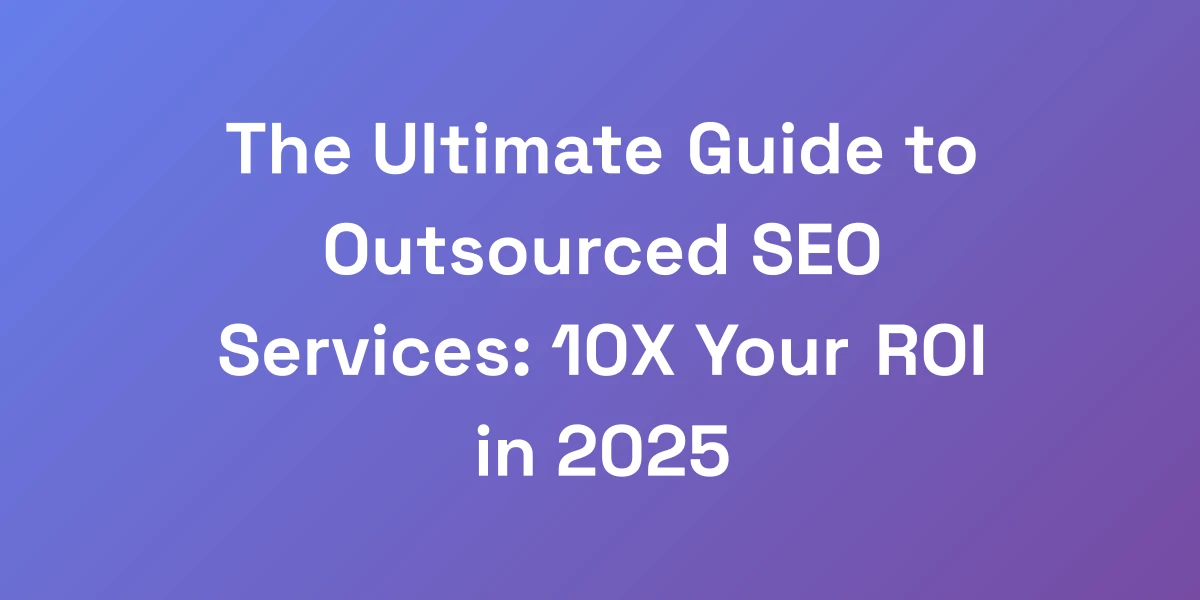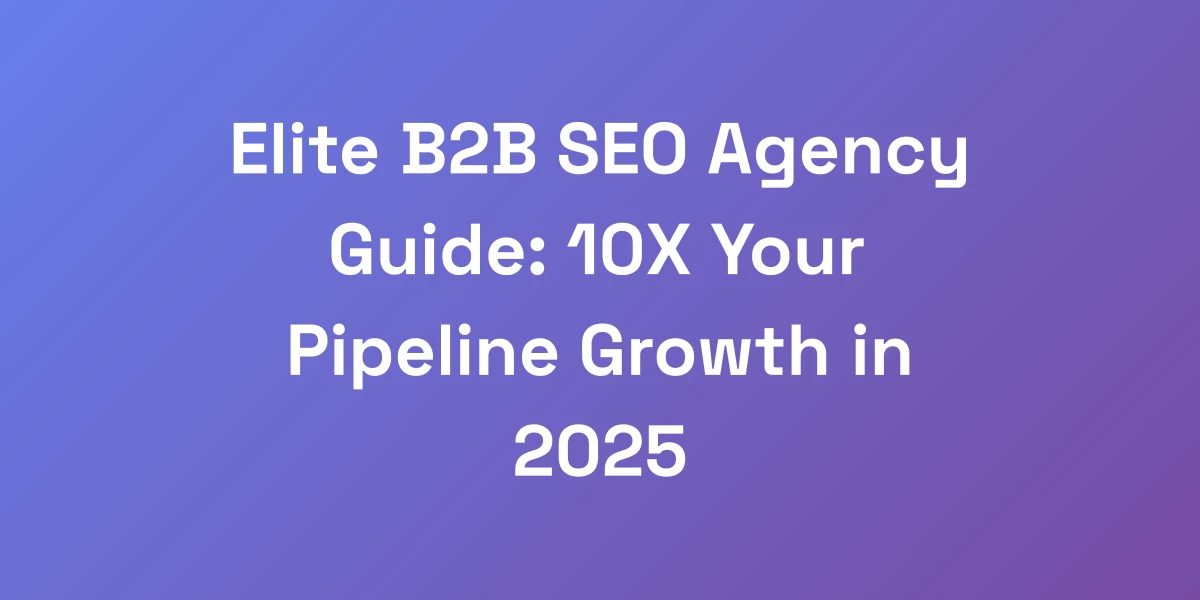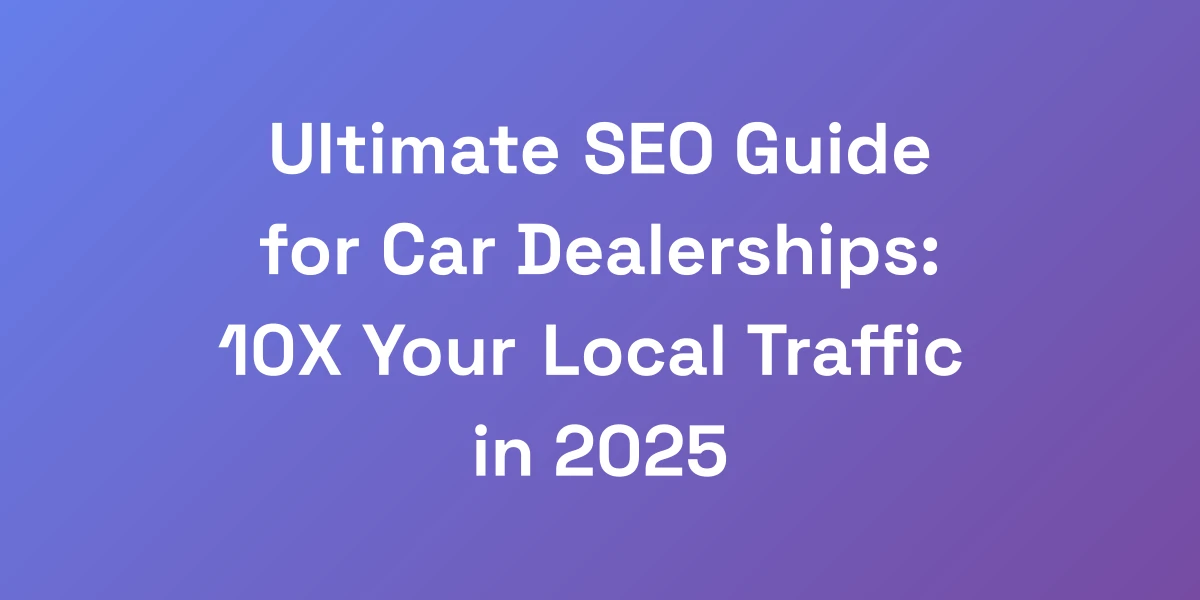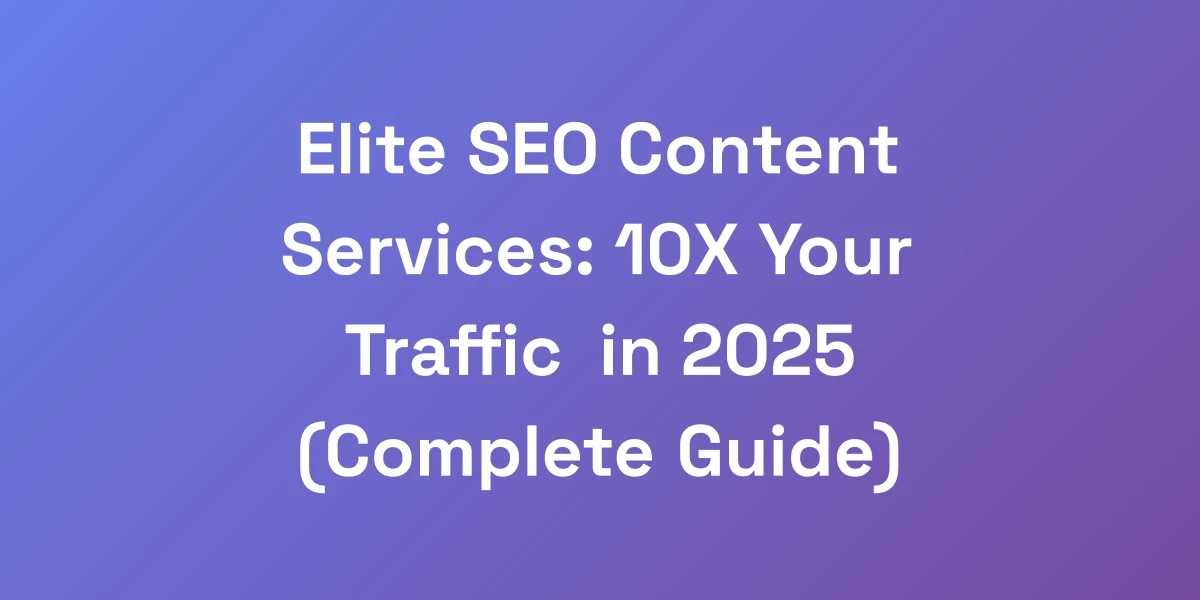
Elite SEO Content Services: 10X Your Traffic in 2025 (Complete Guide)
Mar 31, 2025 | By [email protected]
Why Most Businesses Fail at Content (And How SEO Content Services Fix This)
Let me hit you with some truth: 90% of businesses are bleeding money with content that doesn’t convert.
I’ve seen companies pump out article after article, getting zero return.
Here’s the reality – you don’t have a content problem, you have an execution problem.
Professional SEO content services aren’t just about writing; they’re about creating strategic assets that print money while you sleep.
In this guide, we’re going to show you exactly how to leverage these services to create unstoppable organic traffic machines.
The Hidden Cost of DIY Content Creation
Many businesses fall into the trap of DIY content creation, thinking it saves money and grants total creative control.
However, the hidden costs often outweigh the apparent savings.
- Time Investment: Crafting high-quality content takes significant time. Instead of focusing on core business activities, teams get bogged down in writing, editing, and optimizing.
- Skill Gap: Not everyone is a skilled writer or SEO expert. Poorly written content can harm your brand’s reputation and fail to attract the right audience.
- Opportunity Cost: Time spent on subpar content is time not spent on strategies that could drive real growth, such as product development or customer engagement.
Imagine trying to build a high-performance engine using only basic tools. You might get something running, but it won’t roar down the highway.
That’s what DIY content often feels like compared to the precision and power of professional SEO content services.
Why Most In-House Content Teams Underperform
In-house content teams are a valuable asset, but they often underperform due to several key reasons.
- Lack of Specialization: Content teams may handle everything from writing to SEO, leading to jack-of-all-trades but master-of-none scenarios.
- Resource Constraints: Limited budgets and manpower can stifle creativity and the ability to produce consistent, high-quality content.
- Burnout: Constant pressure to produce can lead to burnout, reducing the quality and consistency of output over time.
It’s like trying to run a marathon with a sprinter’s training. Without the right resources and expertise, in-house teams struggle to keep up with the demands of effective content marketing.
The ROI Mathematics of Professional SEO Content
Professional SEO content services offer a clear return on investment that DIY approaches can’t match.
Consider this: optimized content can attract targeted traffic, leading to higher conversion rates and increased revenue.
- Higher Search Rankings: Quality SEO content ranks higher on search engines, driving more organic traffic.
- Long-Term Benefits: Well-crafted content continues to attract traffic over time, providing ongoing value.
- Enhanced Engagement: Engaging content keeps visitors on your site longer, increasing the likelihood of conversions.
With AI integration, marketers see an average of 70% increase in ROI.
This isn’t just a statistic; it’s a testament to the power of professional SEO content in transforming your business’s bottom line.
Case Study: From 100 to 100,000 Monthly Visitors
Take, for example, a mid-sized e-commerce business that struggled with stagnant traffic.
They partnered with a professional SEO content service and implemented a comprehensive content strategy.
- Initial State: 100 monthly visitors, high bounce rates, low conversions.
- Strategy: In-depth keyword research, creation of long-form, authoritative content, and strategic topic clustering.
- Results: Within six months, monthly visitors skyrocketed to 100,000, with a significant increase in conversions and revenue.
This transformation didn’t happen overnight, but it showcases the potential of professional SEO content services in driving massive traffic growth.
The Truth About Content Quality vs. Quantity
There’s a common misconception that more content equals better results.
In reality, it’s the quality of content that makes the difference.
- Quality Over Quantity: High-quality content attracts and retains visitors, while low-quality content fails to engage and convert.
- SEO Benefits: Search engines prioritize valuable, informative content, not just a high volume of posts.
- User Trust: Quality content builds trust and authority, making users more likely to return and convert.
Think of content as a garden. A few well-tended plants will thrive, while an overgrown garden with poor care fails to flourish.
Core Components of Elite SEO Content Services
Listen up, because this is where most people get it wrong.
Elite SEO content services aren’t just about stuffing keywords into articles.
It’s about building a content ecosystem that dominates your entire market.
The best services combine Technical SEO expertise with psychological triggers that make readers take action.
When you understand these components, you’ll see why most “content writers” are actually killing your business, and why proper SEO content services can 10X your ROI.
Technical SEO Integration
Technical SEO is the backbone of any successful content strategy.
It ensures that your content is easily discoverable and indexable by search engines.
- Site Structure: A well-organized site structure improves crawlability and user experience.
- Page Speed: Fast-loading pages reduce bounce rates and improve rankings.
- Mobile Optimization: With mobile-first indexing, ensuring your site is mobile-friendly is crucial.
- Schema Markup: Implementing structured data helps search engines understand your content better.
By integrating these elements, professional SEO content services ensure that your content is not only high quality but also optimized for maximum visibility.
Content Strategy Development
A robust content strategy is essential for aligning your content with business goals and audience needs.
- Audience Research: Understanding your target audience’s preferences and pain points.
- Content Planning: Developing a roadmap that outlines what content to create, when, and why.
- Goal Setting: Defining clear objectives for each piece of content, whether it’s to inform, engage, or convert.
With a well-defined strategy, your content efforts are purposeful and aligned with your overall business objectives, driving better results.
Keyword Research and Topic Clustering
Effective keyword research is the cornerstone of successful SEO content.
It ensures that your content targets the terms your audience is searching for.
- Comprehensive Research: Identifying high-traffic, low-competition keywords relevant to your niche.
- Topic Clustering: Organizing content around central themes to establish authority and improve SEO.
- Long-Tail Keywords: Focusing on specific phrases that drive highly targeted traffic.
By strategically clustering topics, you create a network of content that enhances your site’s authority and visibility, making it easier for search engines to rank your pages.
Content Optimization Framework
Optimizing content goes beyond keyword placement.
It involves structuring and enhancing your content to meet both user intent and SEO best practices.
- On-Page SEO: Optimizing titles, headers, meta descriptions, and images for better search performance.
- Readability: Ensuring content is easy to read and engaging, with clear formatting and logical flow.
- Internal Linking: Creating connections between related content to improve navigation and SEO.
- External Linking: Referencing authoritative sources to enhance credibility and trustworthiness.
This comprehensive approach ensures that your content not only attracts visitors but also keeps them engaged and drives conversions.
Performance Tracking and Analytics
Without tracking performance, you can’t measure success or make informed decisions.
- Key Metrics: Monitoring traffic, engagement, conversion rates, and rankings.
- Analytics Tools: Utilizing tools like Google Analytics and SEMrush to gather and analyze data.
- Continuous Improvement: Using insights to refine strategies and improve content performance over time.
By consistently tracking and analyzing performance, including keeping up with Google algorithm updates, professional SEO content services can adapt and optimize strategies to ensure ongoing success.
Content Distribution Strategy
Creating great content is only half the battle.
Effective distribution ensures that your content reaches its intended audience.
- SEO: Optimizing content for search engines to drive organic traffic.
- Social Media: Sharing content across social platforms to expand reach and engagement.
- Email Marketing: Distributing content to your email list to drive traffic and conversions.
- Influencer Partnerships: Collaborating with influencers to amplify your content’s visibility.
A well-rounded distribution strategy maximizes the impact of your content, ensuring it reaches the right people at the right time.
How to Choose the Right SEO Content Service Provider
We’re going to save you $100,000 in mistakes right now.
After spending millions on content services, we’ve learned that picking the right provider comes down to five critical factors.
Most people focus on price – that’s amateur hour.
What you need is a provider who understands business objectives first, SEO second.
The best SEO content services don’t just create content; they create revenue-generating assets that appreciate over time.
Red Flags to Watch Out For
- Guaranteed Rankings: Be wary of providers that promise top rankings. SEO is complex and ever-changing, making guarantees unrealistic.
- Poor Communication: If a provider is slow to respond or unclear in their communication, it can lead to misunderstandings and subpar results.
- Lack of Transparency: Providers should be open about their strategies, processes, and pricing. Hidden fees or vague methods are major red flags.
- One-Size-Fits-All Approach: Effective SEO requires customized strategies. Providers that offer generic solutions likely won’t meet your specific needs.
Spotting these red flags early can save you time, money, and frustration, ensuring you partner with a provider that truly supports your goals.
Essential Questions to Ask Providers
- What is your approach to SEO? Understanding their methodology ensures alignment with your business objectives.
- Can you provide case studies or references? Real-world examples demonstrate their capability and success.
- How do you measure success? Ensure they focus on meaningful metrics that drive your business forward.
- What tools and technologies do you use? Advanced tools can enhance the effectiveness of your SEO strategy.
- How do you stay updated with SEO trends? The SEO landscape is constantly evolving, so staying informed is crucial.
Asking these questions helps you gauge the provider’s expertise, reliability, and compatibility with your business needs.
Pricing Models and What They Really Mean
Understanding different pricing models is essential for making an informed decision.
- Monthly Retainers: Provides ongoing SEO support and consistent content creation. Ideal for long-term strategies.
- Hourly Rates: Suitable for businesses that need specific tasks or consultations. Offers flexibility but can become costly over time.
- Project-Based Pricing: Best for one-time projects or specific campaigns. Ensures clear deliverables and budget control.
Each pricing model has its advantages and drawbacks. Choose one that aligns with your budget, needs, and long-term goals.
Portfolio Analysis Framework
Reviewing a provider’s portfolio gives insight into their expertise and success rate.
- Quality of Content: Assess the depth, readability, and engagement of their previous work.
- Diversity of Industries: A versatile portfolio indicates the ability to handle different niches effectively.
- SEO Success: Look for evidence of improved rankings, traffic growth, and other SEO metrics in their case studies.
- Client Testimonials: Positive feedback from previous clients can validate their reliability and effectiveness.
A thorough portfolio analysis helps you determine if the provider has the skills and experience to meet your specific needs.
Service Level Agreement Must-Haves
A comprehensive Service Level Agreement (SLA) sets clear expectations and ensures accountability.
- Scope of Services: Clearly define what is included in the service, such as content creation, SEO optimization, and reporting.
- Performance Metrics: Specify the key performance indicators (KPIs) that will be used to measure success.
- Timelines: Establish deadlines for deliverables and outlines for ongoing work.
- Communication Protocols: Define how and when communication will occur between your team and the provider.
- Payment Terms: Clearly outline the payment schedule, including any milestones or deliverables tied to payments.
Having a well-defined SLA protects both parties and ensures a clear understanding of responsibilities and expectations.
Scale and Capacity Considerations
As your business grows, your content needs will evolve. Ensure your SEO content service provider can scale with you.
- Resource Availability: Confirm they have the manpower and expertise to handle increasing content demands.
- Adaptability: Providers should be flexible and able to adjust strategies based on your growth and changing needs.
- Technology Integration: Utilizing advanced tools and platforms can support scalable content strategies.
Choosing a provider that can scale with your business ensures that your content strategy remains robust and effective as you expand.
Implementing SEO Content Services Successfully
Here’s where the rubber meets the road. Implementation is where 95% of businesses drop the ball.
You need a systematic approach to integrate SEO content services into your existing operations.
We’re talking about creating systems that scale with SEO optimization automation, not just random content pieces.
The difference between 6-figure and 7-figure content campaigns lies in the execution framework you build with your service provider.
First 30 Days Action Plan
- Kickoff Meeting: Align on goals, expectations, and timelines with your provider.
- Audit Existing Content: Evaluate current content for performance and SEO opportunities.
- Keyword Research: Conduct comprehensive keyword and topic research to guide content creation.
- Content Calendar: Develop a detailed content calendar outlining upcoming topics and deadlines.
- Set Up Analytics: Ensure tracking tools are properly configured to monitor performance from day one.
A structured first 30 days sets the foundation for a successful and sustainable content strategy, ensuring all parties are aligned and productive from the start.
Content Calendar Development
A well-planned content calendar ensures consistency and strategic alignment with your business goals.
- Topic Scheduling: Plan topics in advance based on keyword research and audience needs.
- Publication Dates: Assign specific dates for content creation, review, and publication to maintain consistency.
- Content Types: Diversify content formats, including blog posts, videos, infographics, and more.
- Seasonality: Incorporate seasonal trends and events to make content timely and relevant.
A strategic content calendar ensures that your content efforts are organized, timely, and aligned with overall marketing objectives, driving sustained traffic growth.
Quality Control Systems
Maintaining high content quality is non-negotiable for effective SEO.
Implementing rigorous quality control systems ensures consistency and excellence.
- Editorial Guidelines: Establish clear guidelines for tone, style, and formatting to maintain brand consistency.
- Review Processes: Implement multi-tiered review processes involving editors and SEO specialists to ensure content meets standards.
- Feedback Loops: Create mechanisms for continuous feedback and improvement based on performance metrics and stakeholder input.
- Plagiarism Checks: Use tools to ensure all content is original and free from copyright issues.
These systems help maintain the integrity and effectiveness of your content, ensuring it consistently meets both user expectations and SEO requirements.
Team Integration Protocol
Seamless integration between your internal team and the SEO content service provider is crucial for efficiency and effectiveness.
- Communication Channels: Establish clear channels for regular updates, feedback, and collaboration.
- Roles and Responsibilities: Define who is responsible for what to avoid overlaps and ensure accountability.
- Collaborative Tools: Utilize project management tools like Asana or Trello to streamline workflows and track progress.
- Regular Check-Ins: Schedule regular meetings to discuss progress, address challenges, and adjust strategies as needed.
Effective team integration ensures that both your internal team and the service provider work harmoniously towards common goals, maximizing the impact of your SEO content strategy.
ROI Tracking Framework
Tracking the return on investment is essential to measure the effectiveness of your SEO content services.
- Define Metrics: Identify key performance indicators (KPIs) such as traffic, engagement, conversions, and revenue.
- Set Benchmarks: Establish baseline metrics to compare against future performance.
- Regular Reporting: Implement a reporting schedule to review performance data and assess progress.
- Analysis and Adjustment: Analyze the data to identify trends, strengths, and areas for improvement, adjusting strategies accordingly.
A robust ROI tracking framework ensures you can quantify the value of your SEO content investments and make data-driven decisions to enhance performance continuously.
Scaling Strategy Blueprint
Once your initial content strategy is successful, it’s time to scale.
A well-designed scaling strategy blueprint ensures that growth is sustainable and manageable.
- Expand Content Topics: Broaden your content themes to cover more aspects of your industry and audience interests.
- Increase Content Volume: Gradually increase the number of content pieces without compromising quality.
- Leverage Automation: Use tools to automate repetitive tasks, freeing up resources for more strategic initiatives.
- Enhance Team Capacity: Hire additional writers, editors, and SEO specialists as needed to support growth.
- Optimize Processes: Continuously refine your workflows to improve efficiency and output quality.
A strategic approach to scaling ensures that your content efforts grow in tandem with your business, maintaining effectiveness and driving sustained traffic growth.
Measuring and Scaling Your Content Success
Let’s talk numbers, because that’s what matters.
If you’re not measuring, you’re just guessing.
But here’s the kicker – most businesses track the wrong metrics.
We’ll show you exactly what numbers actually matter for your bottom line.
We’re talking about creating predictable content systems that generate consistent returns.
The goal isn’t just traffic; it’s profitable traffic that converts into revenue.
Key Performance Indicators
- Organic Traffic: The number of visitors arriving from search engines. A direct indicator of your SEO efforts.
- Bounce Rate: The percentage of visitors who leave after viewing only one page. Lower rates typically indicate more engaging content.
- Conversion Rate: The percentage of visitors who take a desired action, such as making a purchase or filling out a form.
- Average Session Duration: The average time visitors spend on your site. Longer durations suggest higher engagement.
- Keyword Rankings: Track the positions of your target keywords in search engine results pages (SERPs).
Focusing on these KPIs helps you understand how well your content is performing and where adjustments are needed to drive better results.
ROI Calculation Framework
Understanding the return on your content investments is crucial for assessing their effectiveness.
- Basic Formula: ROI = ([Return – Investment] / Investment) x 100.
This gives you a percentage that reflects the profitability of your content marketing efforts. - Detailed Calculation: Consider all revenue streams generated from content (sales, leads, etc.) and subtract the total cost of content creation and distribution.
- Attribution: Accurately attributing revenue to specific content pieces can be challenging but is essential for precise ROI calculation.
Using this framework allows you to quantify the financial impact of your SEO content services, ensuring that your investments are driving meaningful returns.
Traffic Quality Analysis
It’s not just about driving traffic; it’s about driving the right traffic.
Analyzing traffic quality ensures that the visitors you’re attracting are likely to convert.
- Source Analysis: Identify which channels are driving the most valuable traffic, whether it’s organic search, social media, or referrals.
- Behavior Metrics: Examine how visitors interact with your site, including page views, time on site, and exit pages.
- Demographic Data: Understand the demographics of your audience to tailor content and marketing strategies effectively.
- Engagement Levels: Measure interactions such as comments, shares, and likes to gauge content resonance.
By focusing on traffic quality, you ensure that your content efforts are attracting visitors who are more likely to engage and convert, enhancing overall effectiveness.
Conversion Optimization
Driving traffic is only half the battle; converting that traffic into customers is where the real gains lie.
- Clear CTAs: Use strong, clear calls-to-action to guide visitors towards desired actions.
- Landing Page Optimization: Design landing pages that are user-friendly, fast-loading, and tailored to specific campaigns or content pieces.
- A/B Testing: Continuously test different elements of your pages to identify what drives the highest conversions.
- User Experience (UX): Ensure your site is easy to navigate, visually appealing, and free from distractions that could hinder conversions.
Optimizing for conversions ensures that the traffic generated by your SEO efforts translates into tangible business results, maximizing your return on investment.
Content Asset Valuation
Content is more than just words on a page; it’s a valuable asset that contributes to your brand’s authority and revenue.
- Longevity: High-quality content remains relevant and continues to drive traffic over time, increasing its value.
- Repurposability: Content can be repurposed into different formats, enhancing its overall utility and reach.
- SEO Equity: Well-optimized content builds SEO equity, improving the overall search engine performance of your site.
- Brand Authority: Authoritative content establishes your brand as a trusted leader in your industry, attracting more loyal customers.
Valuing your content assets helps you understand their impact and informs decisions on where to invest for maximum returns.
Scale-Up Trigger Points
Knowing when to scale your content efforts is crucial for sustained growth.
- Consistent Performance: When your content consistently meets or exceeds performance metrics, it’s time to scale.
- Increased Demand: As your audience grows, so does the need for more content to address their needs and interests.
- Resource Availability: Ensure you have the necessary resources, including budget and manpower, to handle increased content production.
- Market Opportunities: Identify emerging trends and opportunities within your market that can be leveraged through expanded content efforts.
Trigger points help you make informed decisions on when and how to scale your content strategy, ensuring continued growth and success.
Conclusion
We’ve walked you through the stark reality of why most businesses fail at content and how elite SEO content services can turn the tide.
From understanding the hidden costs of DIY content creation to the intricate details of choosing the right service provider, every step is crucial.
Remember, it’s not about churning out content; it’s about creating strategic, high-quality content assets that drive traffic and conversions consistently.
Implementing a robust SEO content strategy with the right partner can truly 10X your traffic by 2025.
Ready to transform your content strategy?
Take action today and partner with an elite SEO content service provider that aligns with your business goals and drives measurable results.
What challenges have you faced in your content strategy?
Share your experiences in the comments below and let’s continue the conversation on how to elevate your content game.
